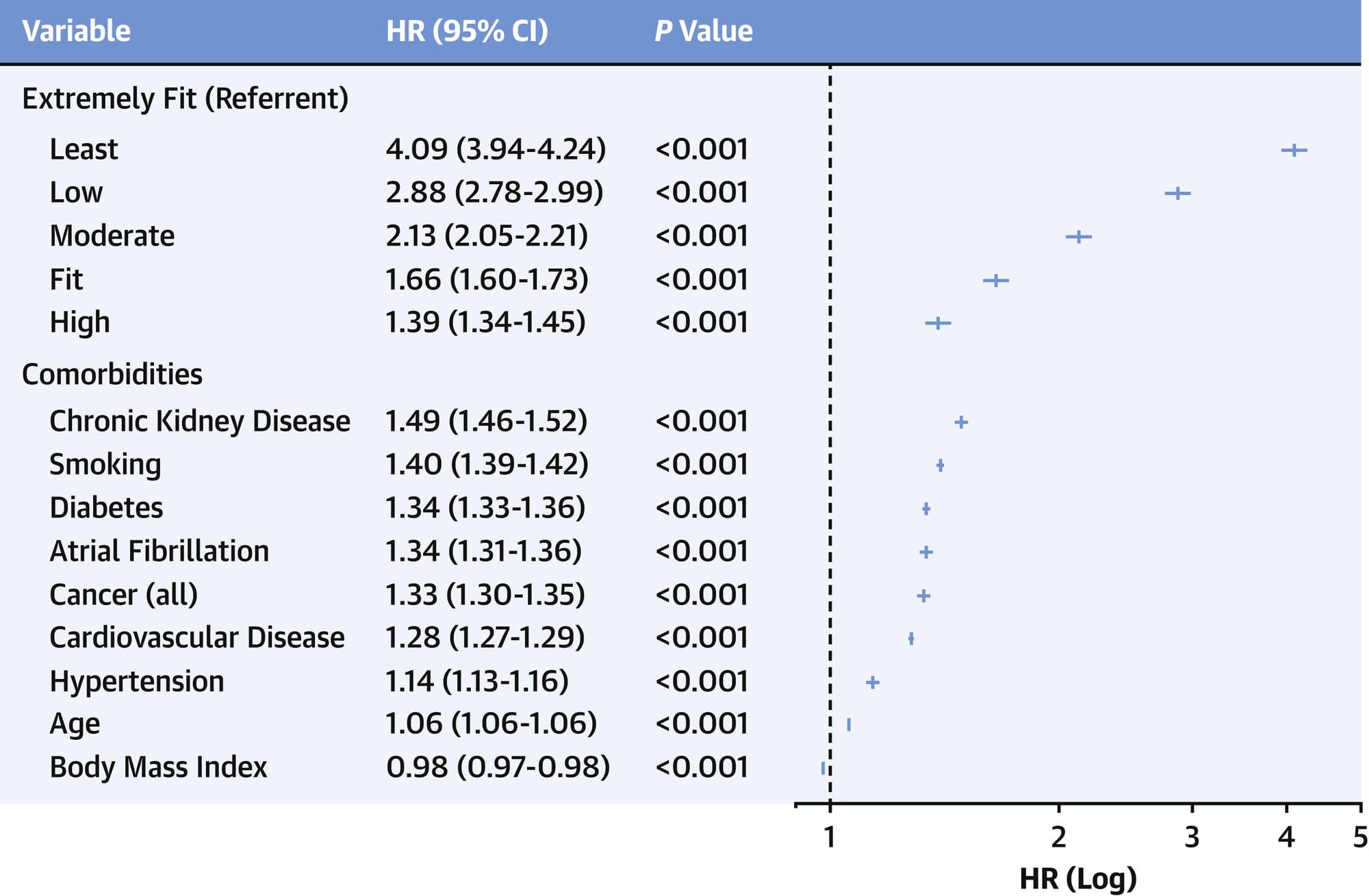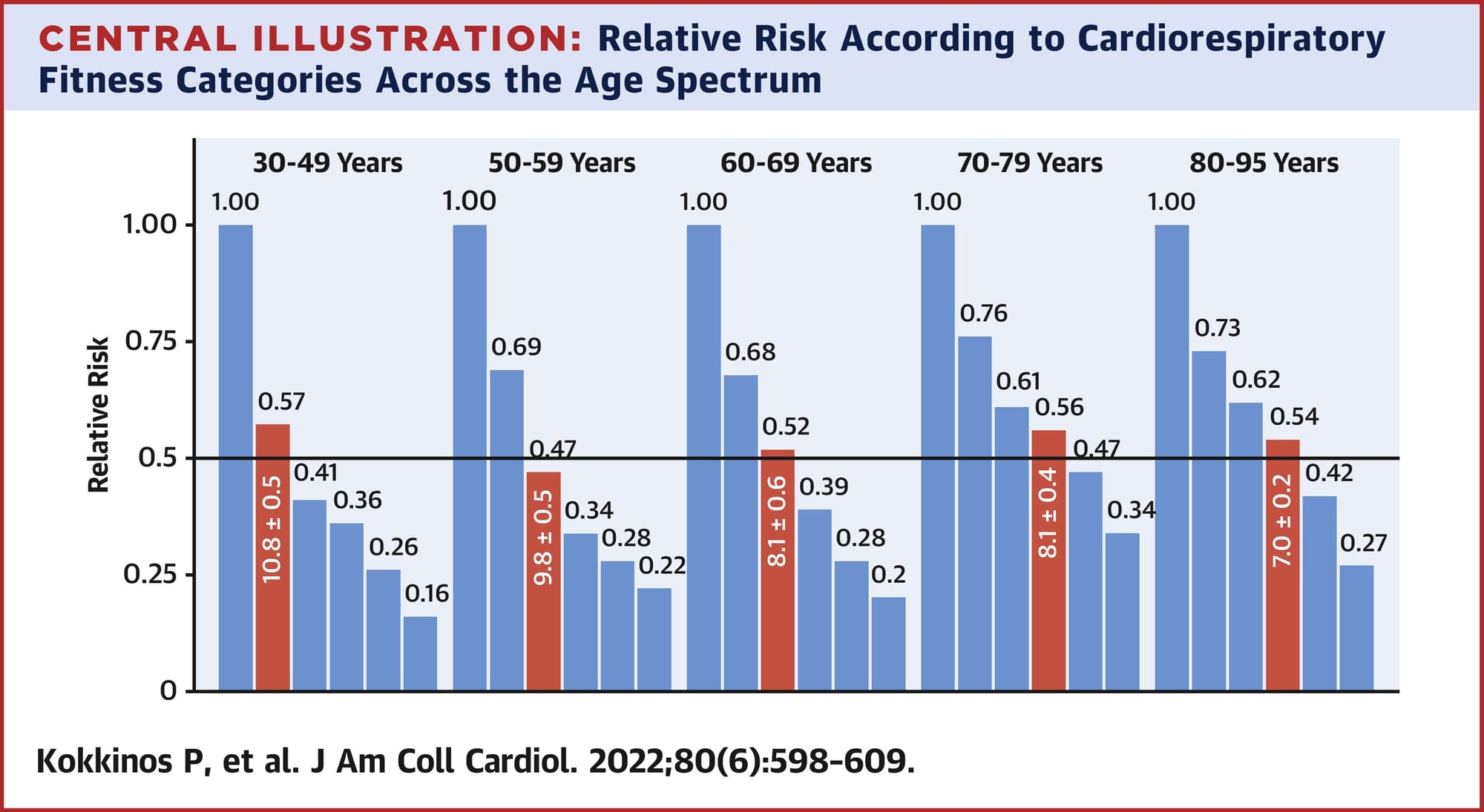The BEST Predictor of Life-Span

If you're a seasoned subscriber to RxTeach, you'll no doubt know that we're huge fans of using exercise to extend life-span and health-span. Our obsession with this approach to health is data-driven. In a previous article covering a publication from 2018, we showed that elite performers were 5 times less likely to die from any cause over 10 years compared to the bottom 25% of performers based on VO2 max testing. If you've never heard of VO2 max, check out this short explanation.
This week we'll quickly cover the results of a study by Kokkinos et al. in 2022 titled Cardiorespiratory Fitness and Mortality Risk Across the Spectra of Age, Race, and Sex. This is a much larger study than the one we covered from 2018 (750,302 subjects vs 122,007 subjects) and it uses data from the Veterans Affairs Medical Center in Washington, DC.

As always, you should keep in mind that this is retrospective epidemiologic data which can not prove causality. Having said that, physicians like Dr. Peter Attia explain that our confidence in these results is based on 5 factors: magnitude of the difference, reproducibility (see study from 2018), dose-dependent response, biological plausibility, and experimental data from humans. Let's dive in.
As I said before, this study included 750,302 subjects who were over the age of 30, achieved a maximal effort during their test of >2.0 METs, had BMIs >18.5 kg/m2, and received follow-up beyond 6 months. Note, one metabolic equivalent (MET) is defined as the amount of oxygen consumed while sitting at rest and is equal to 3.5 mL/kg/min of oxygen (same units as VO2 max).
Over a median follow-up of 10.2 years, 174,807 subjects died. The longest-living men and women had achieved ~14.0 METs (men HR: 0.24; 95% CI: 0.23-0.25 / women HR: 0.23; 95% CI: 0.17-0.29). Importantly, there was no evidence of increased mortality in the fittest subgroups. The all-cause mortality risk in the bottom 20th percentile of performers was 4x higher (HR: 4.09; 95% CI: 3.90-4.20) than extremely fit individuals.
Note that the clinical characteristics of the subgroups are NOT well balanced, which is to be expected. The fitter you are, the less likely you are to have hypertension. For instance, only 35.1% of the "extremely fit" subgroup had hypertension compared to 67.4% of the "least fit" subgroup. Don't worry though, this is adjusted for in the analysis, as were all of the other covariates.

Figure 2 above shows the breakdown between subgroups and HRs for mortality compared to the "extremely fit". Note that the METs achieved by each subgroup ("Least" to "High") were 5, 7, 9, 10, and 12 respectively. In other words, the "High" fitness group was able to achieve nearly 3x more METs than the "Low" fitness group but still less than the 14 METs achieved by the "extremely fit".
The results, I think, speak for themselves. Similar to the findings of Mandsager et al. in 2018, there is a massive decrease in risk associated with being more fit. The fittest subjects were 4x less likely to die of all causes! Not only that, being in the least fit group was more dangerous than having any comorbidity (CKD, smoking, diabetes, atrial fibrillation, etc...) Now, whether a randomized clinical trial of exercise vs smoking would actually show that being in bad shape is more dangerous than smoking is up in the air. I personally doubt it. The same can be said for CKD. Still, there is an obvious signal hear that is difficult to ignore... The higher the fitness, the lower the risk of death over a 10-year period.
Importantly, this benefit was seen regardless of age. The mortality HRs for extremely fit individuals aged 50-59 was 0.22 and 0.27 for individuals aged 80-95. You can visualize this in the figure below:

So what does this study tell us? The good news is that you can almost certainly decrease your risk of death by increasing your cardiorespiratory fitness through exercise. The bad news is that you have to start NOW. Don't wait!! The truth is that the most fit 80-year-olds were almost certainly "extremely fit" when they were in their 50s and 60s! Like your GPA, fitness is easier to maintain than it is to build, particularly as you get older. Your VO2 max will decrease over time, no matter what you do. The key is to get it as high as you can now and then hold on to it for as long as you can.
If you're already in later life, don't fret! There's still immense benefit in starting now, and you CAN increase both muscle mass and VO2 max in your later years, especially if you're an untrained individual. Get after it, folks!
*Information presented on RxTeach does not represent the opinion of any specific company, organization, or team other than the authors themselves. No patient-provider relationship is created.


